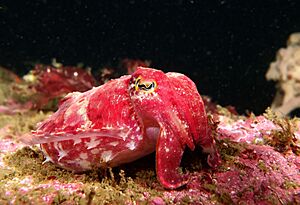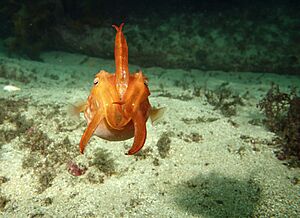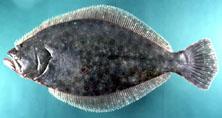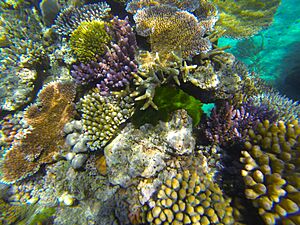Reaper cuttlefish facts for kids
Quick facts for kids Reaper cuttlefish |
|
|---|---|
 |
|
| Conservation status | |
| Scientific classification | |
| Genus: |
Sepia
|
| Species: |
mestus
|
| Synonyms | |
|
|
The Sepia mestus, also known as the reaper cuttlefish or red cuttlefish, is a type of cuttlefish. It lives in the southwestern Pacific Ocean. You can find it near Queensland (15°47′S 145°47′E / 15.783°S 145.783°E) and Murrays Beach off Jervis Bay (35°08′S 150°46′E / 35.133°S 150.767°E) in Australia. Some old reports from China and Vietnam were actually about different species.
This cuttlefish lives in water that is 0 to 22 meters (about 0 to 72 feet) deep.
Sepia mestus males and females are different sizes. Females can grow up to 124 millimeters (about 4.9 inches) long. Males are smaller, reaching only about 77 millimeters (about 3 inches) long.
The very first Sepia mestus sample was found off the coast of Australia. It is now kept at The Natural History Museum in London.
Contents
About Cuttlefish Bodies
Cuttlefish, like other cephalopods, have similar body plans. They have a ring of arms around their mouth. Their main body parts, like their breathing and eating organs, are inside a muscular bag called the mantle. This mantle is at the back of the animal.
Cuttlefish, including S. mestus, have two extra limbs that octopuses do not have. These are called feeding tentacles. They are found between the third and fourth arms. Cuttlefish use these tentacles to quickly grab their prey.
Unlike octopuses, cuttlefish have a hard, internal shell called a cuttlebone. This gives their body shape. In octopuses, the head and body are joined together.
Sepia mestus is often called the red cuttlefish. When it is not disturbed, it usually looks red. It also has two dark spots on its back.
Sepia mestus can see differences in light patterns. This is called the polarizing drum.
How Cuttlefish Move
Sepia mestus moves through the water using a special method. Many cephalopods use this method. They push water out of a space inside their mantle. This water shoots out through a tube called a funnel. This way of moving is called jet propulsion.
When the mantle is relaxed, water fills the space inside. When the mantle tightens, it pushes the water out through the funnel. The cuttlefish can point the funnel in different directions. This allows it to move forward or backward. This helps it escape from predators or chase prey.
What Cuttlefish Eat and Who Eats Them
Some animals that eat S. mestus include bluefish, summer flounder, and black seabass.
S. mestus and other cuttlefish often eat shrimp, crabs, and small fish.
How Cuttlefish Hide from Danger
Cuttlefish are amazing at camouflage. This means they can change their color and texture very quickly. This helps them hide from animals that might want to eat them.
They have tiny organs in their skin called chromatophores. These are like small bags filled with color. The cuttlefish can make these bags bigger or smaller. This lets them show different colors.
Sepia mestus and most other cuttlefish can also change how their skin feels. They can push up special skin flaps called papillae. This helps them look like rocks, coral, or seaweed. By tightening muscles around these flaps, they can make them rise up. This changes how the cuttlefish looks.
Sepia mestus can also dig into the sand to hide from predators.
Life Cycle and Mating
To find a partner, a male cuttlefish will perform special displays. These displays help him get the female's attention. Once a male is successful, he will use a special arm called a hectocotylus. He uses it to fertilize the female's eggs.
The female then lays her eggs nearby. All cuttlefish, including S. mestus, attach their eggs to the seafloor. They usually place them on or under hard surfaces like rocks or coral.
After laying and protecting their eggs, the adult male and female cuttlefish usually die. Like most Cephalopods, S. mestus have separate male and female sexes. The embryos grow for about two months. Then, they hatch and spend a short time floating in the water. After that, they grow into adult cuttlefish.
Where They Live
Sepia mestus is found only in Australia. It lives along the east coast. You can find it from northern Queensland down to Jervis Bay in New South Wales.
Cuttlefish Homes
Sepia mestus lives in tropical waters up to 22 meters (about 72 feet) deep.
They usually live on rocky reefs. You can often see them hiding under ledges.
Many types of cuttlefish live in Australian waters, including S. mestus.
Protecting the Reaper Cuttlefish
The Sepia mestus is currently considered a species of "least concern." This means it is not in immediate danger of disappearing.
What Could Threaten Them
Rising levels of carbon dioxide in the air are a possible threat. This causes ocean acidification, which means the ocean water becomes more acidic. This could affect all cuttlefish species.
If there is too much carbon dioxide, cuttlefish might grow a denser cuttlebone. A heavier cuttlebone could make it harder for them to float and move properly in the water.





